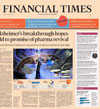Most big-deal acquisitions, however unexpected, make sense once they are in place. And the sale of the Financial Times, though quickly consummated since first reports Sunday, was not all that surprising.
Here are my quick thoughts on why Japanese Nikkei won the trophy newspaper and what may happen next:
- No longer a fit: As Pearson has become an education company with smaller news holdings, it needs to concentrate on its primary business. The FT group has some specialized financial products but nothing on the scale of Bloomberg, Dow Jones, Thomson Reuters — or Nikkei for that matter. There are few synergies with the education unit.In retrospect, the sale may have been telegraphed two years ago when CEO John Fallon, who had been running the education unit’s international business, succeeded American-born Marjorie Scardino, whose roots were in publishing, particularly The Economist (in which Pearson retains a 50 percent interest for now).
- Captial for the next wave of growth — I take Fallon at his word when he said in the press release this morning announcing the sale:
We’ve reached an inflection point in media, driven by the explosive growth of mobile and social. In this new environment, the best way to ensure the FT’s journalistic and commercial success is for it to be part of a global, digital news company.
That’s to say that in internal competition for capital, FT would run behind the considerable needs of the slumping education publishing and testing business. Not being able to invest in the next big and needed expansion efforts is always a good reason to move on, even from a very strong and high-profile business.
That was the thinking of family owners of the Washington Post and Wall Street Journal when they reluctantly sold and of Poynter’s Tampa Bay Times when it dealt Congressional Quarterly to the Roll Call subsidiary of The Economist.
- Nikkei brings money and a good match: With reports as late as this morning that German publishing giant Axel Springer would be the buyer and earlier expressions of interest from Michael Bloomberg, it’s safe to assume that multiple suitors were in the mix. I think it is also safe to assume that Nikkei wanted the FT most and bid more ($1.3 billion) than the others.The New York Times’ David Jolly nicely explains the way the acquisition fits Nikkei’s situation:
Japanese newspapers’ vast print circulations have helped cushion them against the technological and financial challenges of the Internet age. Yet that advantage has had a negative side: Online offerings have lagged, leaving Japanese publications vulnerable to shifting reader preferences. Even in Tokyo, print readership is declining, especially among the young, and many editors and publishers fear their publications lack the digital skills and experience to respond.
Nikkei’s three-million-circulation flagship business paper of the same name already has licensed FT content, Jolly adds, and the company launched an English-language magazine and website in 2013, Nikkei Asian Review. Reuters Jennifer Saba suggests that Nikkei paid about three times the typical multiple for the FT Group — a much higher premium than Rupert Murdoch’s sweet offer for Dow Jones.
- English language and asset, England business base not so much: In the global era, publishing in the world’s most broadly popular language is a huge plus. FT demonstrated the reverse in a venture a few years back launching a German language edition which then folded for lack of scale. German or Japanese publishers, however profitable and capable, have a brake on international growth since comparatively few outside their borders read the language.While the FT reliably delivers an insightful international report, a London base with correspondents and a sales force strategically deployed around the world is a business model relic from the second half of the 20th Century. Opportunity has moved east to Asia. Don’t look for FT to pack up and move to Tokyo, but a two-continent presence will be valuable moving forward. I expect the FT sale will be noted in Britain as yet one more marker of the decline of empire — and rightly so.
- Not a fixer upper: FT is in solid shape financially with 2014 profits of $37 million on sales of $518 million. Highly respected for its reporting, story selection, and concise but elegant writing, the FT has also managed as well as anyone a transition from print to paid digital subscriptions, now 70 percent of its 730,000 circulation.Looking in from the outside, I can’t see the need for drastic changes. Nikkei, of course, can do what it wants, but I would bet on not meddling with a good thing and making management changes only gradually. Indeed holding talented staff who could easily jump elsewhere may be a first order of business.That leaves the always debated question of how best to describe the distinctive color of paper on which the FT is printed. My colleague Ben Mullin went with bisque this morning, which is much more precise than pink. I would opt for salmon.







